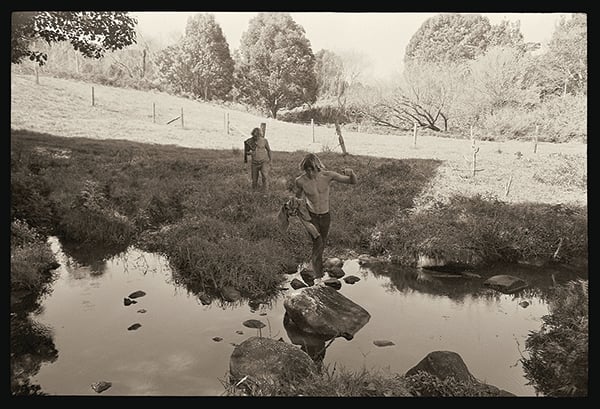
Arcadia: In the late 1960s there was a definite movement by surfers to leave the cities and to go to live in the coastal towns near the best surfing breaks in Australia. This happened right across the country, but nowhere was it so pronounced as on the north coast of New South Wales, with the Byron Bay area a singular magnet. This picture shows Wayne Lynch and Bob McTavish in the beautiful country around Possum Creek. It was taken in 1969 and featured in the ‘Country Soul’ issue of Surf International magazine.
Arcadia is an exhibition of lyrical, richly textured photographs by John Witzig, co-founder of Tracks magazine and founder of SeaNotes, with huge ink drawings by Nicholas Harding and psychedelic film footage by Albe Falzon. Imbued with a romantic conception of the awesome and spiritually restorative force of the sea, it expresses the free-spirited, revolutionary character of a group of young and perfectly formed Australian surfers in the early 1970s. Photographer John Witzig answered a few questions about this exhibition curated by Sarah Engledow.
What was it about the era that is so evocative? Your photos make me think of a time when we didn’t look at our phones, where a single day could stretch almost a week…
Yeah, no phones, that’s for sure. I was working for several surfing magazines through a 15-year period from 1966, so there were deadlines of course (and we were actually reasonably professional), but somehow it was remarkably more relaxed… but evocative? I’m not sure. For whatever reason we’ve invested that period with romantic notions that only reflect a part of what it was actually like. It isn’t in the interests of the myth-makers to disavow what people have come to believe about the time, but it simply was romantic. Way more so than now, that’s for sure.
Surfing almost seems to be a different sport these days – your photos remind us of a time when it was intrinsically linked to counterculture; now it seems more about the dollar… is that something you have noticed?
‘Modern’ surfing had really only arrived in Australia in the very late 1950s, so by the early 70s it was still an adolescent. That tells you something about our behaviour, but we were also hugely influenced by adventure and exploration. More kids got their hands on cars and we explored every dirt track that we could find on the coast.
The link with counterculture is real because some of it was happening in a similar period. But the Aquarius Festival wasn’t until 1973. Surfers had been obsessive about the northern NSW coast for more than a decade before that.
And yes, a different sport now… a different world. Change happens.
You have some amazing shots of Wayne Lynch and Bob McTavish at Possum Creek. Can you tell me about when those were taken?
The picture of Wayne Lynch and Bob McTavish that I call Arcadia was taken in 1969 at Possum Creek. I was working for a magazine called Surf International and was planning a ‘Country Soul’ issue. That sentiment reflected my own feelings about how and where I wanted to live, and what I observed in many of the people I hung around with. That the picture happened at all tells you about the advantage of carrying a camera a lot of the time… something that I clearly did. There is nothing staged about that photograph (or the one of Wayne at the pool that Sarah wrote such a beautiful caption for)… merely the capturing of moments. That they might become emblematic of a period isn’t something that you can know at the time.
What are the highlights of the exhibition? Who are the surfing legends featured here?
In a funny way I don’t think that there are highlights. Well, there’s the ‘hero’ shot of course, and quite a number of other pictures that’ve been blown up to two metres wide or high. That’s pretty amazing. Astonishing actually. There aren’t too many surfing heroes, and that doesn’t matter for a moment. There is Albe Falzon’s superb portrait of Nat Young. Nat’s tangled hair got Sarah Engledow thinking of Nicholas Harding’s wonderful HUGE ink drawings of the north coast coastal scrub… an inspired connection.
Why black and white?
All the photographic heroes from my late teenage years shot in black and white. I was taking more colour in the later 1960s because Surf International ran a lot of it, but my main love has always been black and white. In 1970 David Elfick, Albe Falzon and I started Tracks and it was only black and white for the first couple of years. I also liked being able to process the film and do the prints myself.
Tweed Regional Gallery and Margaret Olley Art Centre Murwillumbah; open Wednesday to Sunday 10am–5pm,(DST) as daylight saving time will come into effect from Sunday 4 October.
Opening Friday 5.15pm for an exhibition preview floor talk by Dr Sarah Engledow, music by Windy Hill and opened officially at 6.30pm by Robert Drewe.



